

|
Home Updates Hydros Cars Engines Contacts Links Racing Contact On The Wire |
Long Lost lakes
As the tethered hydroplane community comes to terms with the unfortunate situation that there are only two venues left in the country where hydros can be run we can but reflect on the huge number of lakes and ponds that have hosted hydroplane racing since a line was first attached to a boat in 1908. Ironic in a way that the two lakes left are Victoria, one of the very first to be used and Kingsbury one of the last to come into operation. Although we have already been sent a great deal of material, hard information about locations, periods of use and notable runners would be much appreciated. Current photos of the venues wherever possible would also be a fitting post script to each.
South Cerney: Home of the Cotswold Model Marine Club. The open nature of the lake and the fact that it was shared with full sized boats required breakwaters to be constructed that can be seen in the photos. Reports from Model Boats emphasise the very social nature of events there. Problems at the lake firstly required the pylon to be moved and later forced a move to another venue close by that the Club was only able to use for a relatively short period of time. As can be seen from the second panel of photos, the lake has now been filled in with a view to development.
 |
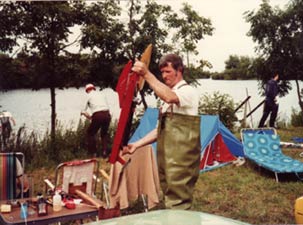 |
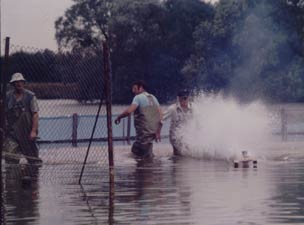 |
| Stu Robinson, Jim Williams, Lionel Lawley | B Class record holder John Rose | Arthur Wall and 'Doc' English launching |
 |
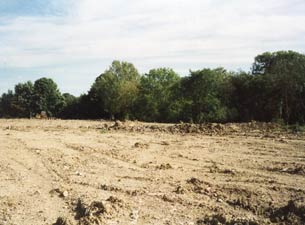 |
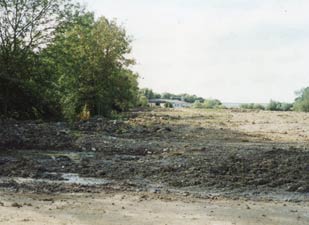 |
| Entrance to the lake | Location of the pole! | Wot, no water? |
Postscript from Kevin Fleet Aug 2020
After
my last trip past the old South Cerney venue in November 2018 I fully
expected to see lakeside chalets or houses for weekend retreats
constructed and ready to move in to with £650,000+ price tags on them.
As in 2018 they were putting kerbstones in from the main road and all
the David Bellamy undergrowth had all been cleared from inside the site,
now they’ve just put up these metal gates and big bollards where the
photo is taken from to stop illicit entry into the site.
It really is a great shame to think apart from some of the lake being
filled in nothing has been used or done on this site since the Cotswold
club were asked to leave twenty five years ago, and to a lot of members
of the hydroplane club this venue will bring back many fond and happy
memories. Anyway I just thought I would forward you the latest photo to
show you how the site looks today
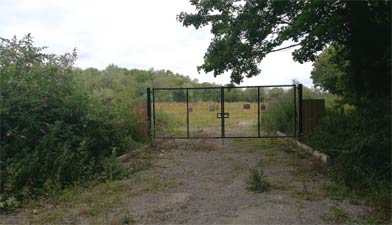 |
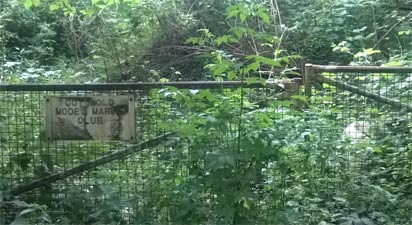 |
| No development as yet 25 years on | The sign says it all. Cotswold Model Marine Club |
Photos kindly provided by Kevin Fleet, Mike Rose and Margaret Lawley
Swindon:
The Swindon Model Boat Club is one of the longer established in this
country having come into existence around 1931. The Cheney Manor Lake in
the north west suburbs of Swindon, also knows as Plaum's Pit, hosted
regattas from the late 1930s until well into the 1970s. By then it was
surrounded by an industrial estate and housing. The lake had a path
around the whole perimeter where the Ford Anglia van can be seen. The
lake is now a fishing lake with the club moving to other waters, but no
more hydros.
 |
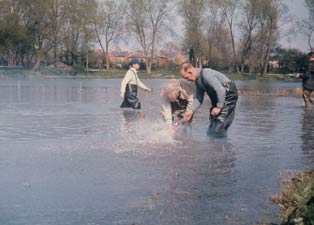 |
 |
| Hydro on a run. Ford Anglia in background | Doc English & Ted Blacknell | Frank Jutton and TNT |
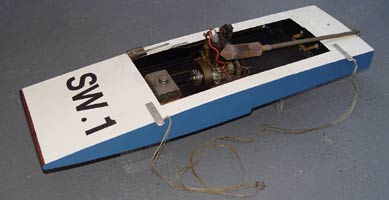 |
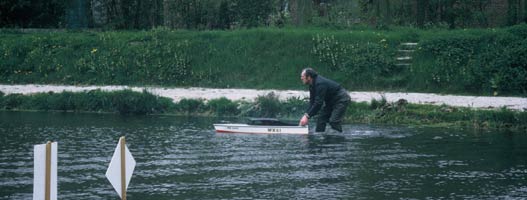 |
| Home club boat, Mr Baxter's Miss Swindon | Jim Williams with a straight running boat |
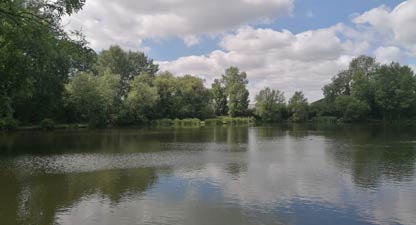 |
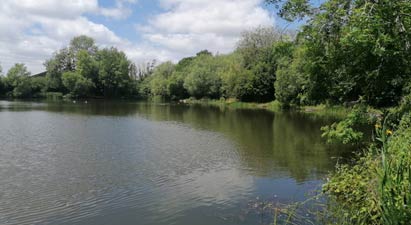 |
|
Nigh on fifty years on and now a fishing lake |
|
Photos and captions again kindly provided by Kevin Fleet
Old Ford:
|
In the early 70s, the Kingfisher Club realised that they were in imminent danger of losing their water near Elstead in Surrey so set about raising funds via a share scheme to enable them to rent a new site. After a great deal of searching they found an area that would be suitable behind the Old Ford pub at North Camp Farnborough, bounded by the river on one side and a railway line on the other. The minor complication was that there was no lake and no water so an excavator was hired to dig a 2ft deep lake around 150 ft by 200ft. This needed a membrane covered by 2" of sand and 300,000 gallons of water pumped from the River Blackwater. Much of the impetus for the hydroplane facilities at the new lake was believed to be down to Frank Jutton and Jim Bamford |
|
Building pit areas, launching platforms and shelters, along with landscaping and planting occupied club members until the official opening in April 1974. The lake was built to accommodate all forms of model boats, including hydroplanes, but all with very strict adherence to the noise limit. Attendances slowly dropped away over the next few years until Kingfisher member Don Reid suggested that it might be an ideal venue for tethered hydroplanes then running at Cerney and Bradwell.
The lake hosted around five or so hydroplane events throughout the season with Sheila Reid providing refreshment from her stall and Don running the meetings. It was reckoned by many to be the ‘fastest lake in the country’ with numerous records being broken there and always runnable because of the surrounding trees and banks. The Reids both died within a short while of each other in 2000 and 2001 but problems were already emerging. Unfortunately, after tenure of just on thirty years, a change in ownership of the brewery that owned the site and the death of the landlord of the pub led to the pub being closed so no running was possible in 2003 and all forms of boating brought to an end in 2004. With no maintenance or topping up of water the lake effectively vanished to be replaced by scrub and saplings. It could be resurrected but would require huge amounts of work and a considerable investment in time and money. The combination of the M25, M3 and A331 made travelling to and from the lake from anywhere north of the metropolis something of an adventure, and getting home on a Sunday night even more fraught. A bit like Cerney really, if you wanted to go there you would be better off starting from somewhere else?
 |
 |
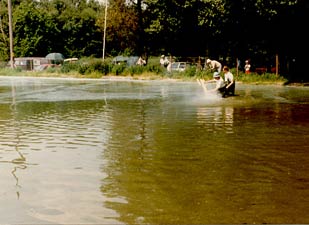 |
| Norman Lara with 'Sharkie' | The 'pit area' | Rose family in action |
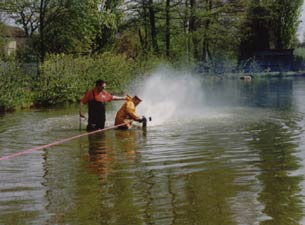 |
 |
 |
| Norman and John Hyder | Ian Berne with A Class steamer | 130 +mph with A class boat |
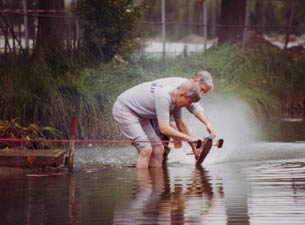 |
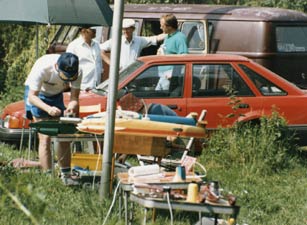 |
 |
| John Rose and John Whelan | More pit action | Terry Everitt assisting Ian |
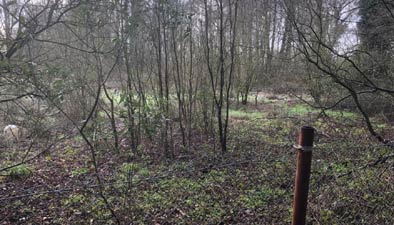 |
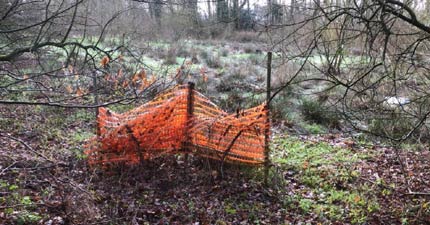 |
|
The sad sight that once was 'the fastest lake in the country' |
|
Thanks to Norman Lara for the latest photos. The site can still be identified, just, on Google maps but now looks like a wood.
Woburn:
Yes, the lake was actually on the Woburn estate and not far from the Abbey. Huge death duties in the mid 50s led the new Duke and Duchess of Bedford to try and maximise income rather than hand the whole lot over to the National Trust. Peter Lambert and Ken Hyder negotiated the use of one of the lakes, setting up the Woburn Model Hydroplane Club. This was unusual in that any potential member had to be registered with the MPBA through another club before joining. Fishing, model boats, model aircraft and large country fairs all featured during the 60s until the Duke passed on the running of the estate to his son, The Marquis of Tavistock and his wife Henrietta Tiarks. Their grand plan was based round a safari park that was established in 1970 and included getting rid of all the multifarious users of the Park that did not quite 'cut it' with her ladyship. So after little more than ten years of use Woburn was lost in the early 70s. The Woburn Club morphed into the Model Hydroplane Club and a number of original members still have fond memories of the lake. Thanks to Rick Benson for modern photos of the lake.
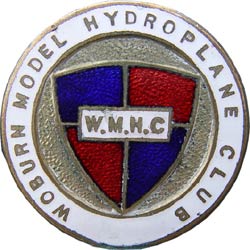 |
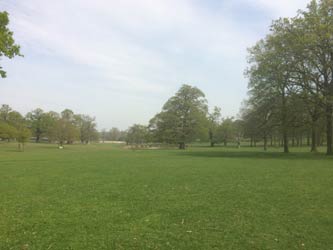 |
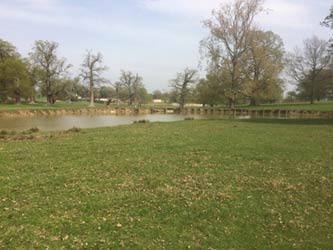 |
Southampton Ornamental Lake:
The Southampton Society of model Engineers enjoyed the use of a large and wadeable lake on Southampton Common where a number of enthusiasts from both the Portsmouth and Southampton Clubs ran regular events that were supported by competitors from all over Southern England, and on occasions by contingents from France. By the mid 1960s hydroplane events were being run there by a specially formed committee that became the Hampshire and South Coast Club as there were no longer any hydro members at Southampton. In 1966 an innovation was the adoption of the timing system that is still in use where the competitor raises their hand to start the timed laps rather than the set number of run in laps that had to be declared prior to the run. An all too familiar story of falling membership and increasing public pressure made running hydros ever more difficult and even actively discouraged. By the end of the 1960s, both southern venues had been lost with the Ornamental Lake being given over to fishing.
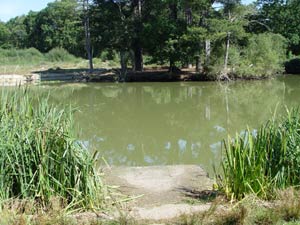 |
 |
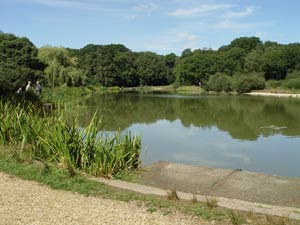 |
| 2006 Lake set up for fishing | 1958 Southampton Regatta | Forty eight years on, same view |
Cove Common Reservoir Farnborough:
During the 1930s, the Farnborough Club held a series of regattas on the Cove Common Reservoir, which was just to the west of the Royal Aircraft Establishment at Farnborough and a short distance from the western perimeter of the airfield. The outbreak of war brought all official boating activities to an end in Britain; while the location of the reservoir was to bring about the demise of the venue. Its proximity to the airfield also led to a number of planes ending up in the reservoir over the years, slightly less messy than in the sewage farm adjoining Brooklands?
 |
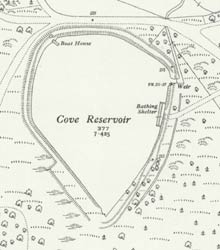 |
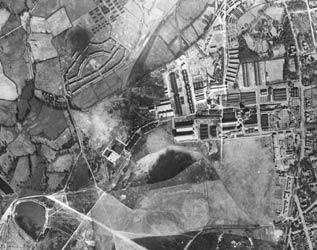 |
| Bathing shelter on the reservoir | Plan of reservoir | Reservoir left and Farnborough airfield |
The reservoir was a bathing lake, hosted the local model yacht club as well as the MPBA regattas. Although the pole was close to the bank, the water was so deep that recovery had to be by boat, a duty carried out by Charles Lutz in his canoe on occasions. A regular event at regattas was the towing race, with straight runners and hydros pulling a dinghy or float around a set course. Lying flat and holding on to a 30cc hydro or flash steamer by hand while it tows you around must have been a bit hairy and very messy. The Farnborough version was notable for the prize, which was the famous ‘Farnborough Marrow’.
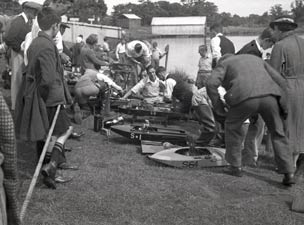 |
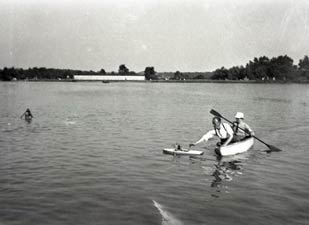 |
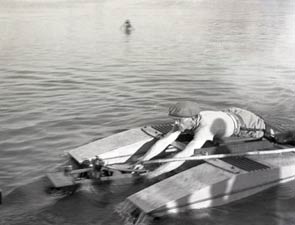 |
| Line up of hydros in the pits | Charles Lutz on recovery duties | 30cc 'Betty' on towing duties |
Both Cove and the nearby Fleet reservoir were drained at the beginning of the war to stop them being used as navigations aids for German bombers. The airfield at Farnborough had to be extended and as the reservoir was directly in the path, it was filled and vanished under runways. Usually we finish with a modern photo of the venue, but in this case it really is a Long Lost Lake as it disappeared forever and the only recognition that it was ever there is Reservoir Road on the industrial estate that borders the airfield.
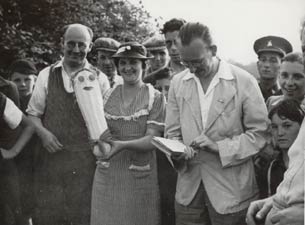 |
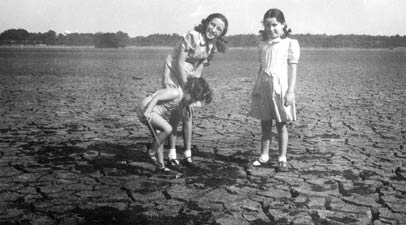 |
| The 'infamous Farnborough Marrow' trophy | The fate of the reservoir and the nearby Fleet Pond |
Thanks to Steve McKeown for photos of the reservoir and the Westbury Family archive for regatta images.
©copyrightOTW2022